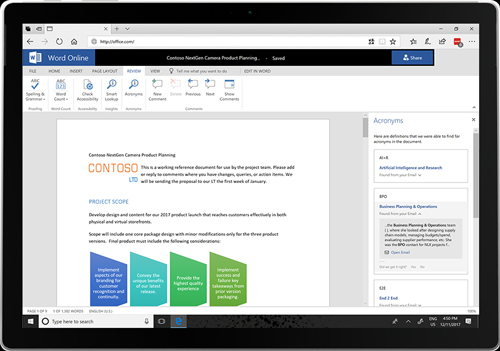Posey's Tips & Tricks
Office 365 Gets Serious About Artificial Intelligence
Here are some of the more practical ways Microsoft is using its vast machine learning and AI assets to make its productivity suite more useful.
Late last year, Microsoft released a significant amount of information about how the company is infusing artificial intelligence (AI) capabilities into Office 365.
The talk didn't seem to get quite as much attention as something like this normally would, presumably because it happened right around the holidays. Even so, I found the discussion to be fascinating. While there was way too much information presented for me to cover in a single column, I wanted to take the opportunity to share my thoughts on a few key points.
Decipher Company Lingo
One of the things that always baffled me about the corporate world was how each organization seems to have its own form of corporate-speak. Many years ago, I used to work for the U.S. Department of Defense. Believe me when I say that the military has an acronym for practically everything. Sometimes, a single acronym can even have multiple meanings. "POV," for example, could mean "point of view," "privately owned vehicle" or half a dozen other things.
In more recent years, I have found that the space program also makes extensive use of acronyms. Terms such as MECO ("main engine cut off) and G-LOC (G-force-induced loss of consciousness") get thrown around quite liberally.
Even in the corporate world, there were plenty of terms that left me scratching my head -- and, of course, there are countless acronyms used in IT.
One of the things that Microsoft has been working on is using AI to decipher corporate-speak. The feature is officially called Acronyms. It works by using the Microsoft Graph to analyze e-mails and documents in order to gain an understanding of what acronyms tend to be used in the organization, and what those acronyms mean. Those definitions are then surfaced through Microsoft Word whenever the corresponding acronyms appear in a document.
Microsoft has provided the below screen capture illustrating how this feature will work. Word's Review tab will contain an Acronyms button. When selected, this button will reveal a pane on the right side of the screen showing a list of the acronyms used in the document and what those acronyms actually mean.
 [Click on image for larger view.] The upcoming Acronyms feature in Word. (Source: Microsoft)
[Click on image for larger view.] The upcoming Acronyms feature in Word. (Source: Microsoft)
Intelligent Search
Another new capability that I am really excited about is Intelligent Search. Intelligent Search will allow you to extract searchable text from image files. The idea is to make it easier to find things such as receipts, business cards and more.
Intelligent Search actually stems from something that Microsoft has been working on for quite a while. Back in 2016, I wrote a column explaining how Microsoft had released a tool called Office Lens that could turn images captured by a smartphone's camera into editable text. At the time, I had somewhat mixed success with using Office Lens.
From what I have been able to gather, the new Intelligent Search capabilities build on what already existed with Office Lens. Rather than working solely with pictures captured by a smartphone camera, Intelligent Search will be able to analyze the contents of OneDrive and SharePoint libraries, looking for text within image files. That text will then presumably be indexed, making it possible for Office users to locate images that are relevant to search queries.
Time to Go
One more thing that caught my attention was something called Time to Go. The basic idea is that Cortana is able to take what it knows and figure out when you need to leave for an appointment in order to be on time. Some of the information that Cortana considers when determining when you need to leave includes your current location, your destination location, the time of your appointment (which it can get from your Outlook calendar), traffic en route and public transportation schedules.
Incidentally, Time to Go isn't designed to be used solely by those who use public transportation. If you prefer to drive, it's no problem. Cortana can plot driving directions, examine the traffic along the way and figure out the best time to leave. Cortana will even send you a notification (which includes the directions) when it is time to go.
I can only imagine how much smarter Time to Go will get over time. As it stands now, Time to Go is great for going from Point A to Point B, but just imagine the possibilities if you are headed to the airport to catch a flight. In the future, Cortana could conceivably take into account the airport parking situation, the length of the security lines and whether or not your flight is expected to be on time.
About the Author
Brien Posey is a 22-time Microsoft MVP with decades of IT experience. As a freelance writer, Posey has written thousands of articles and contributed to several dozen books on a wide variety of IT topics. Prior to going freelance, Posey was a CIO for a national chain of hospitals and health care facilities. He has also served as a network administrator for some of the country's largest insurance companies and for the Department of Defense at Fort Knox. In addition to his continued work in IT, Posey has spent the last several years actively training as a commercial scientist-astronaut candidate in preparation to fly on a mission to study polar mesospheric clouds from space. You can follow his spaceflight training on his Web site.